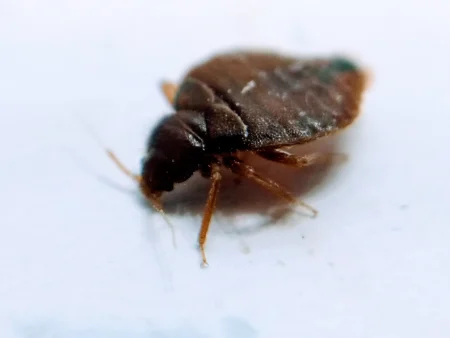From the moment you first notice bug bites after rolling out of bed, the alarm sets in. “Do I have bed bugs?” So you perform a bed bug inspection checking your mattress and bed frame and sure enough there they are. Besides the growing itch, your only concerns are, “How do I get rid of them?” and “How long will it take until they are gone?”
Though many factors come into play, which we will discuss, a general rule of thumb is that it will take a minimum of two treatments, each about 2 weeks apart, totaling one month minimum.
Now before you decide to drop everything and move, know that it is 100% possible to get rid of bed bugs. Here’s a general timeline of what to expect from discovering an infestation to relaxing in a bed bug-free home.
Discovery
So you confirmed there are bed bugs in your room? But what about the rest of your home? Though you can do an inspection yourself, the best course of action is to get an integrated pest management (IPM) professional to visit. They will be able to provide a thorough inspection and determine the level of infestation which will shape not only the timeline, but the cost as well.
Let’s look at what to expect depending on what your inspection reveals:
Factors That Influence How Long It Takes To Eliminate Bed Bugs
There are five factors that can reduce or lengthen the time it takes to have a bed bug-free home. The first thing an IPM professional will discuss is the level of infestation.
Level of Infestation
Infestations can be categorized into two levels:
Minimal Infestation (1-3 hours):
- Contained to a single room or studio apartment
- Early detection where bed bugs are few in number
- Not many hiding places (easy access to treat the entire space)
Severe Infestation:
- Bed bugs have spread to several rooms
- Late-stage detection where bed bugs have extensively reproduced
- Lots of hiding places (hard to access all areas)
Size & Type Of Dwelling
Going hand in hand with the severity of infestation, the size of your home or apartment will impact your treatment plan. Keep in mind that the larger the space is, and the number of hiding spots, the more treatments you will likely need. Also, if you are living in a shared building whether that be a town-home or apartment, it will take the collaboration of your neighbors to keep bed bugs at bay as they could be living next door and be migrating between units.
Preparation Before Treatment
Though a good IPM professional will be able to work around your space it’s important to take the time to prepare for a bed bug treatment. A few things that can make treatments more effective and speed up the process:
- Wash all linens
- Vacuum all carpets and rugs
- Declutter your home so exterminators have space to move around this includes moving furniture away from the wall
- Bathe animals and vacate them from the premises
- Do not move items around your house or put into storage
Treatment Method Used
There are several common methods for getting rid of bed bugs, chemical treatments, heat treatments, and steam treatments.
Chemical Treatments:
Generally require 2-3 visits over 3-6 weeks, as insecticides may not kill eggs and additional treatments are needed to address newly hatched bed bugs.
Heat Treatments
Typically faster, with one session potentially eliminating bed bugs. In order to achieve maximum effectiveness, a temperature of at least 120°F must be maintained throughout the home for an hour and a half. This is the length of time needed for eggs to die. In most cases, we recommend 135-145 degrees for around 6 hours to be safe.
Steam Treatments:
Similar to heat treatments, steam relies on temperatures upwards of 250°F to kill all bed bugs and eggs that come into contact with it. Treatment takes 2-6 hours. Due to the nature of needing to come in contact with bed bugs and eggs, hiding spots, and cluttered homes could require multiple treatments.
How Mobile You Are
Though a bed bug infestation can be solved in as little as one treatment, if you are frequently traveling, your luggage can reintroduce bed bugs back into your home. Make sure any time you travel you check your room for bed bugs and switch immediately if you find any signs of an infestation.
Pest Management Professional’s Expertise
A treatment is only as good as the technician servicing your home. An experienced IPM professional will know the common areas that bed bugs hide and will be thorough in their inspection and treatment. What you might save on getting a less experienced professional you will pay for in needing more treatments in the future.
It’s Been A Few Weeks Now What?
It’s perfectly normal that a few weeks after treatment you might find bed bugs. This is due to bed bugs being shielded by clutter, hidden from the area of treatment, reintroduced from an adjacent home, and slew of other reasons that have kept them alive. That is why it’s important to continue to check for signs of bed bugs. In fact bed bugs can be dormant for up to 6 months, so it’s important to be consistent in your inspections.
It’s recommended that you schedule a follow-up with an IPM professional to ensure a proper inspection. If you have discussed needing multiple treatments you can expect treatments to be spaced 2 weeks apart.
Generally the absence of bites, feces, eggs, or any other signs of bed bugs for 3 or more weeks means you are in the clear.
Get A Free Consultation
Bed bugs are becoming a serious problem in upstate New York. If you think you might have bed bugs, it’s best to take action. Our IPM professionals offer thorough on-site consultations. To schedule an inspection use the form below or give us a call: (855) GET-ENVIRO


